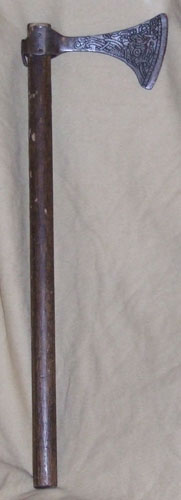Beard: Difference between revisions
From Cunnan
Jump to navigationJump to search
(wanted article) |
No edit summary |
||
| Line 1: | Line 1: | ||
[[image:mammemaxe.jpg|right|200px|thumb|Bearded axe.]] |
|||
| ⚫ | |||
==Beard (Facial hair)== |
|||
A '''beard''' is the facial hair of a human (typically male) that covers the chin and underneath, cheeks, and sometimes extends to the upper lip (in the case of a full beard). |
|||
This might be a mark of manhood at different times, but often during the [[medieval]] period, men went shaven. The Vikings prided themselves on their beards ensuring that they were well kept. |
|||
Some medieval peersonalities (eg. Svein Forkbeard) were noted for their facial hair. |
|||
==Beard (Weapon part)== |
|||
| ⚫ | |||
[[category:weapon parts]] |
|||
Revision as of 16:39, 15 March 2006
Beard (Facial hair)
A beard is the facial hair of a human (typically male) that covers the chin and underneath, cheeks, and sometimes extends to the upper lip (in the case of a full beard).
This might be a mark of manhood at different times, but often during the medieval period, men went shaven. The Vikings prided themselves on their beards ensuring that they were well kept.
Some medieval peersonalities (eg. Svein Forkbeard) were noted for their facial hair.
Beard (Weapon part)
Beard is a term used to describe the downwards projection of some axe blades. This is relatively common in axes from the Viking Age and also very common in medieval woodworking axes.
